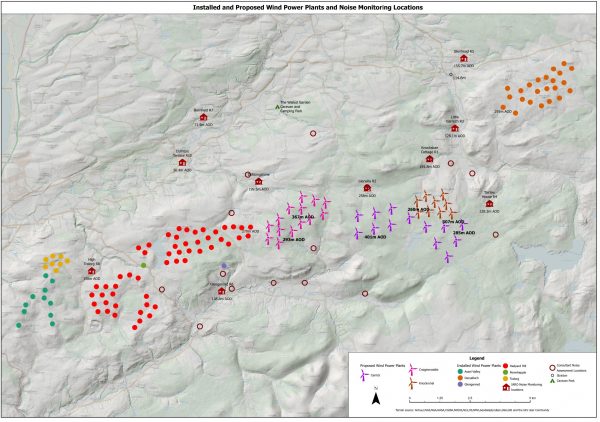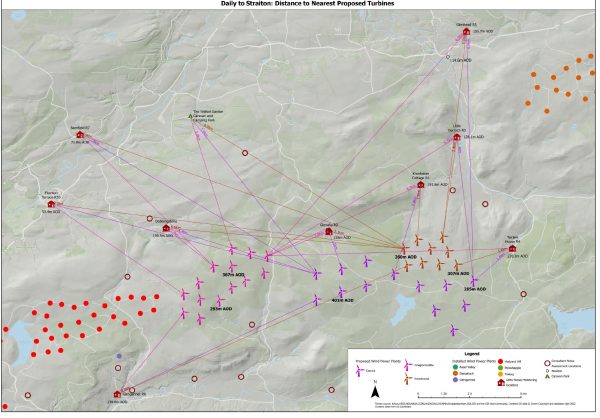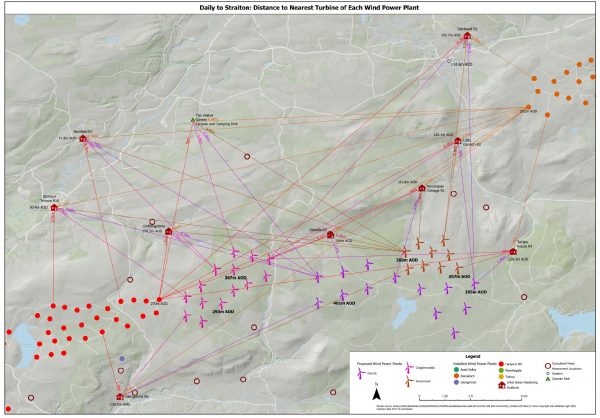All documents are in the public domain and published on the DPEA website
WIN 370-4 Craiginmoddie Wind Farm, Dailly, South Ayrshire, KA26.
WIN 370-5 Carrick Wind Farm, Approximately South Ayrshire, KA19.
WIN 370-6 Knockcronal Wind Farm, Knockcronal, Straiton, South Ayrshire, KA19.
ON BEHALF OF Save Straiton for Scotland.
The full Inquiry Sessions can be viewed at:
The Noise Hearing Session Tuesday 30th May here
and Wednesday 31st May Noise Hearing Session
Landscape and Visual Amenity Evening Hearing
The second part of this inquiry report focusses on matters arising from the hearing sessions, the condition session and the in person Landscape and Visual Amenity Hearing Session which was held in the Carrick Centre, Maybole, on the evening of the 6th June which can be viewed here
When watching, one can click on the agenda item, however item 7 seems to default to item 8 so keep listening on from item 6.
Residential Amenity evening Session Hearing Statement.
Save Straiton Evening Session Hearing Statement_ contains and builds on submission document Save Straiton witness statements and previous references.
Introduction Maps – South Ayrshire Supplementary Guidance & Witness
Statements.
This is an interactive map with a set of layers you can turn on and off, click on things for
a table to pop up and zoom in and out. It is work in progress.

Click here for the interactive map
Reference copies of A1 size Printed hard copies provided at Residential Amenity Session.

Click here for the interactive map

Matters arising from the Noise hearing Sessions:
Operational Noise Information
Matter 1: Save Straiton for Scotland to provide the three documents proposed for submission at the noise hearing on 30/31 May 2023 (Hadyard Hill Wind Farm, CD.SS20 Compliance April 2016 and CD. SS21 Compliance July 2016, and Save Straiton for Scotland Compliance testing Hadyard Hill Summary and conclusions_ in relation to these documents) and provide any additional commentary to support the submission of these documents. Matters for Reporters Noise.
1: The two reports are very similar with the report dated July 2016 superseding the earlier TNEI report.
The benefits of the reports are that:
- ON/OFF testing provided the actual contribution of noise from the Hadyard Hill Wind Farm.
- This information will assist in improving the noise predictions for each proposed wind farm development.
2. CONSIDERATION OF TNEI REPORT 10548-004, JULY 2016 (report)
- The investigation report considered the noise impact upon a complainant’s property.
- Table 1 in Annex 6 of the report details that the predicted sound pressure level at this property was 43.8 dBA, which was the predicted LA90 for all wind turbines on in a wind speed of 12 m/s in a downwind sector.
- The analysis shown in the report covers testing in sectors covering 75° to 270°, as shown in Figure A1.1. of Annex 1 in the report. This wind direction range includes both upwind and downwind directions, not only the downwind conditions that would be assumed worst case.
- Despite the averaging of upwind and downwind data the report shows in Annex 7 (results with wind speeds up to 12 m/s) shows that the ‘Specific Wind Turbine Noise (ON minus OFF)’ according to ETSU-R-97 in the quiet daytime is 56.8 dBA and is 57.8 dBA at night time in a wind speed of 12 m/s.
- It is clear that the predicted sound levels at this property of 43.8 dBA in a downwind sector was incorrectly calculated when the actual sound levels average 57.3 dBA for the quiet daytime and night periods have been measured.
- This data demonstrates that the ‘conservative’ assessment methods using ETSU-R-97 and the IoA Good Practice Guidelines are far from conservative/optimistic.
- This underestimation of the true sound level impact amounts to 13.5 dB.
- It is unsurprising that Ms Trayner, a resident on the other side of the Hadyard Hill wind farm, who provided evidence to the Hearing, experienced severe adverse reactions to noise from the Hadyard Hill wind farm . When she contacted the operators regularly to request that turbines be turned off, an arrangement was made to automatically turn certain turbines off when the wind blows from a particular direction.
- It is clear from the results detailed in the report that predictions of noise at surrounding dwellings to the Hadyard Hill wind farm were grossly underestimated using ETSU-R-97 and the IoA Good Practice Guidelines.
- A more conservative assessment methodology has been provided by Huson in the Hearing whereby noise modelling should account for a ground absorption value of G=0 when using ISO9613-2 and consideration of site effects and tested wind turbine sound power data should be included in noise predictions.
- Given that predicted sound levels from the three proposed developments have no compliance margins the three developments will not comply with basic target noise limits.
- A combined noise impact assessment has been provided for the existing and proposed wind farms but all of the combined assessments used the now demonstrated incorrect prediction methodology.
- At the very least, each of the three developments must reconsider and recalculate the cumulative noise impact assessments based upon actual measured data from existing wind farms (not predicted levels in the development application phases) with revised input parameters.
- In summary, the current applications each underestimate noise levels in the surrounding community and do not show compliance with target noise limits outlined in ETSU-R-97 and the target noise limits required by the South Ayrshire Council of 35 dBA.
Both these compliance testing reports for Hadyard Hill are relevant to the Inquiry in that they relate to the complaints discussed in CD.17.002 paragraphs 3 and 4. They confirm the evidence that ETSU R 97 and the Good Practice Guide and their reliance on ‘Conditions’ to be policed by Local Councils, is fundamentally failing to protect the health and well being of windfarm neighbours.
As details of how these Compliance Reports were part of the complaint described in CD17.02 paragraph 4.3, could not be brought to the reporter’s attention at the hearing, it will be discussed briefly here. The full documents paint a very disturbing picture.
- This Compliance Testing was conducted as a result of Noise Abatement Notification 15/01888/NOIOTH/1 being served, as part of the ongoing noise complaint, described in paragraph CD.07 002 4.3 and detailed in the transcripts evidenced in the documents contained in CD.17 04. All the following documents are referenced in CD.17 03 and found in and CD 17 04:
- 00206B95FCA8170828141758 provides further background and time-line from July 2015 to July 2017 – the lengthy process seemingly required to examine compliance with the noise conditions.
- 500583 and SV-ABH-PRN-01_GPV56341_2534_001 contain SAC’s Abatement Notification of 22nd February 2016 which was superseded by it being re-issued on 24th February 2016. Firstly the Abatement Notification was sent to SSEPlc and not SSE Generation 508048. The Abatement order was never served and the TNEI Compliance testing was set up as part of the ongoing complaint.
- 526290-290416 is the detailed Meeting held in the Council Offices on 29th April 2016 to discuss the April compliance report. This meeting states that some turbines were switched off at night as a good neighbour gesture.
- 514065: 11th May: Complainant: “Firstly I accept you have invested substantial resources investigating our nuisance complaint which resulted in an Abatement notice being served on SSE, lets take that as a starting point or are you now saying that … was mistaken in her determination of the turbines being a nuisance. You keep referring to noise levels although our complaint is about nuisance and you seem to be saying that that is based on levels.”
- An Abatement order is backed by full investigation and the council legal team before being served; therefore the circumstances of any individual employee of the council could not directly affect such an order which is being claimed by the EHO. Is this obfuscation, prevarication and delay? The question is, why are councils acting in this way? Are they afraid to serve an abatement order on a windfarm?
- 513478 The reason for the second compliance testing: EHO: “The intention of the new monitoring exercise by TNEI on behalf of SSE Generation is to examine what mitigation is required in order to reduce the noise levels to within the permitted levels. As previously discussed, however, an exceedance of the agreed noise limits does not necessarily constitute a statutory nuisance.”
- There follows numerous documents: 553865/ 553864/ 585571/ 564977 where the council is stating that their investigation is closed. 556163 where the council EHO states that the council has discharged its duty to access nuisance when clearly there is a huge unresolved acoustic problem.
- The fact that the Compliance Reports clearly both showed Non Compliance of the Hadyard Hill Turbines – No action was taken to remedy this on behalf of these residents.
- In our experience this is not an isolated case or peculiar to one council and again highlights the danger of continuing to use ETSU R-97 and the Good Practice Guide Noise Planning Conditions as a means to protect health and well-being of those living in close proximity to industrial wind turbines.
Matter 2: Save Straiton for Scotland to submit the ‘ Den-Brook-appeal-decision in full and copies of Scottish planning decisions which are said in their submissions to contain planning conditions which deal with amplitude modulation.
Matter 3: Save Straiton for Scotland to submit DEFRA NAN-R45 document/standard which was referred to at the hearing and in their submissions:
Matter 4: Participants of the noise hearing to provide pdf copies of reports or studies which they specifically referred to at the hearing but were not part of the Core Documents (e.g. referred as footnotes from other documents) where they consider that such reports were to be of intertest to reporters for these cases:
NANR277-windfarm-noise-statutory-nuisance
Rushforth-et-al-2002.Case-study-of-Low-Frequency-Noise
- The Rushforth paper is referenced in DEFRA NAN-R45 and it has significance in that a pulsing sound observed periodically at 12.5Hz was the cause of noise complaints that were identified to be from a bag plant in a factory nearby. The instantaneous peak-pressure-amplitudes of the 12.5 Hz bursts reached values of 0.2 Pa and 0.1 Pa at H3 and H2 respectively, equivalent to root-can-square sound pressure levels of 77 dB and 71 dB (eg. Figure 12 showing peak to trough maxima of 0.6 Pa). This is well below the commonly referenced ISO or DIN 45680 hearing thresholds but were clearly observed by residents in their homes. Pressure pulses from wind turbines are at similar sound levels.
- The paper by Tickell shows the difference in using ISO9613-2 with G=0 and G=0.5 to be 4 dB, implemented using CadnaA in Table 1.
End
Noise Conditions were discussed at the end of day 2 0f the Noise Hearing Sessions
Save Straiton had presented their preferred ideal ‘wish list’ of – Conditions of Consent – Noise
However, abiding by Scottish Government Policy ETSU-R-97 and the Good practice Guide, Save Straiton presented Save Straiton Amendments to Operational Wind Turbine Noise Condition 37..at the Conditions hearing Session.
A summary is to follow as requested by reporters

 European Platform Against Windfarms
European Platform Against Windfarms